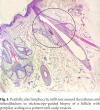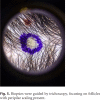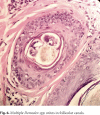Scalp Rosacea: Rethinking Peripilar Scaling
- PMID: 34604328
- PMCID: PMC8436626
- DOI: 10.1159/000514565
Scalp Rosacea: Rethinking Peripilar Scaling
Abstract
Introduction: Scalp rosacea is scarcely reported in the literature, but it is probably not uncommon. Trichoscopic findings have not been specifically established for this entity.
Case presentation: We report 4 cases of chronic scalp rosacea with trichoscopic evidence of peripilar scaling that resolved without scarring after treatment.
Discussion/conclusion: Chronic and persistent inflammation around the isthmus produced in scalp rosacea may form peripilar scaling resembling that found in lichen planopilaris.
Keywords: Dermoscopy; Peripilar scaling; Scalp rosacea; Trichoscopy.
Copyright © 2021 by S. Karger AG, Basel.
Conflict of interest statement
Antonella Tosti served as a consultant or advisor for DS Laboratories, Monat Global, Almirall, Thirty Madison, Pfizer, and Leo Pharmaceuticals. All other authors have no conflicts of interest to disclose.
Figures







Similar articles
-
Differential diagnosis of red scalp: the importance of trichoscopy.Clin Exp Dermatol. 2024 Aug 22;49(9):961-968. doi: 10.1093/ced/llad366. Clin Exp Dermatol. 2024. PMID: 37935061 Review.
-
Frontal Fibrosing Alopecia Severity Index: A Trichoscopic Visual Scale That Correlates Thickness of Peripilar Casts with Severity of Inflammatory Changes at Pathology.Skin Appendage Disord. 2018 Oct;4(4):277-280. doi: 10.1159/000487158. Epub 2018 Mar 2. Skin Appendage Disord. 2018. PMID: 30410896 Free PMC article.
-
Occipital Fibrosing Alopecia in a Young Male: A Case Report.Skin Appendage Disord. 2021 Jan;7(1):71-74. doi: 10.1159/000512034. Epub 2020 Dec 17. Skin Appendage Disord. 2021. PMID: 33614725 Free PMC article.
-
Clinical, Trichoscopic, and Histopathological Features of Primary Cicatricial Alopecias: A Retrospective Observational Study at a Tertiary Care Centre of North East India.Int J Trichology. 2015 Jul-Sep;7(3):107-12. doi: 10.4103/0974-7753.167459. Int J Trichology. 2015. PMID: 26622153 Free PMC article.
-
Trichoscopy of Dark Scalp.Skin Appendage Disord. 2018 Nov;5(1):1-8. doi: 10.1159/000488885. Epub 2018 Jul 18. Skin Appendage Disord. 2018. PMID: 30643773 Free PMC article. Review.
Cited by
-
A Practical Algorithm for the Management of Superficial Folliculitis of the Scalp: 10 Years of Clinical and Dermoscopy Experience.Dermatol Pract Concept. 2023 Jul 1;13(3):e2023131. doi: 10.5826/dpc.1303a131. Dermatol Pract Concept. 2023. PMID: 37557142 Free PMC article.
-
Macrophages in rosacea: pathogenesis and therapeutic potential.Front Immunol. 2025 Jul 31;16:1595493. doi: 10.3389/fimmu.2025.1595493. eCollection 2025. Front Immunol. 2025. PMID: 40821784 Free PMC article. Review.
-
Red Scalp Disease: An Underdiagnosed Entity.Skin Appendage Disord. 2025 Jun;11(3):291-295. doi: 10.1159/000542573. Epub 2024 Nov 19. Skin Appendage Disord. 2025. PMID: 40475104
References
-
- Miguel-Gomez L, Fonda-Pascual P, Vano-Galvan S, Carrillo-Gijon R, Muñoz-Zato E. Extrafacial rosacea with predominant scalp involvement. Indian J Dermatol Venereol Leprol. 2015;81((5)):511–3. - PubMed
-
- Schaller M, Bostanci S, Borelli C. Treatment of extrafacial rosacea with low-dose isotretinoin. Acta Derm Venereol. 2010;90((4)):409–10. - PubMed
-
- Fortuna MC, Garelli V, Pranteda G, Romaniello F, Cardone M, Carlesimo M, et al. A case of scalp rosacea treated with low dose doxycycline and probiotic therapy and literature review on therapeutic options. Dermatol Ther. 2016;29((4)):249–51. - PubMed
-
- Lallas A, Argenziano G, Apalla Z, Gourhant JY, Zaballos P, Di Lernia V, et al. Dermoscopic patterns of common facial inflammatory skin diseases. J Eur Acad Dermatol Venereol. 2014;28((5)):609–14. - PubMed
Publication types
LinkOut - more resources
Full Text Sources

